Extra test round just to be sure
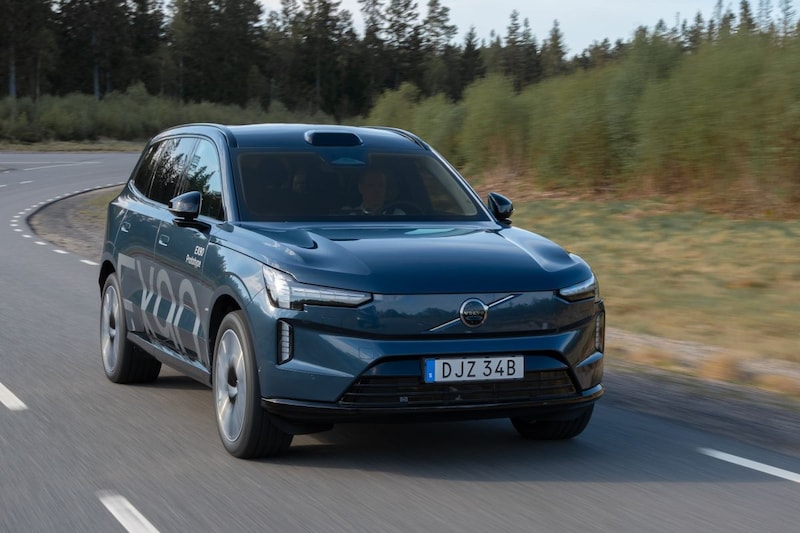
Just under a year ago, colleague Marco Gorter was a guest at the same location where we are today: in Hällered, about 40 kilometers east of Gothenburg, where Volvo has been testing its new products on their 700-hectare test track since 1973. Or better said: ‘proving ground’, a collection of about twenty test tracks of all kinds where the Volvos are subjected to test and development programs before the final product is ready to hit the market. Where Marco took a seat in the brand’s smallest electric SUV, the EX30, today the largest is ready for us: the EX90. A completely new model that requires further text and explanation.
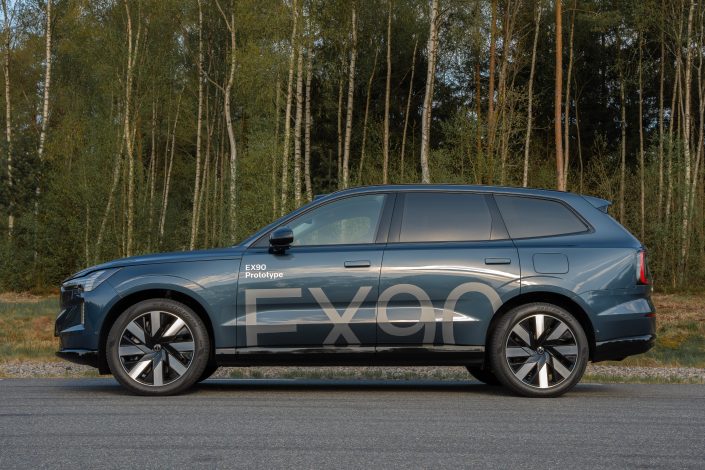
A prototype of the Volvo EX90 on the test track in Sweden.
Off the radar
At least, that’s what Volvo believes, because before we get behind the wheel of the EX90 in August, today is all about riding along and gathering the necessary background information about the car. That doesn’t hurt in the case of the EX90, because that car was in danger of disappearing from the radar after Volvo faced setbacks in the launch process after the official presentation of the model at the end of 2022. This mainly had to do with the coordination of the central computer and all related systems such as the LiDAR, that ‘pimple’ above the windscreen that houses the equipment that scans the environment in front of the car and passes this information on to all (safety) systems. board. The EX90 is the first model in which Volvo uses such a centralized software setup.

The bump above the windshield that houses the LiDAR technology.
EX90 next to XC90
Let’s quickly catch you up on the EX90 before we get into driving it. You can see the EX90 as the fully electric brother of the XC90, the SUV with a combustion engine and/or hybrid drivetrain. It does not replace it, both models are sold side by side, although for bpm technical reasons the range of the XC90 in the Netherlands is limited to one version: the plugin hybrid T8. The EX90, just like the the EX90 on comfort. Place it in the same corner as, for example, the Mercedes EQS SUV, the BMW iX and the Audi Q8 e-tron: an oversized premium SUV. If you look purely at six or seven-seaters in this segment, then only the EQS SUV remains. There are alternatives in the form of the Tesla Model X and Kia EV9.
Its creators call the EX90 the safest Volvo ever. In addition to the traditional and proverbial reliability, Volvo still considers itself a pioneer when it comes to safety. This word is simply anchored in the DNA of the brand.
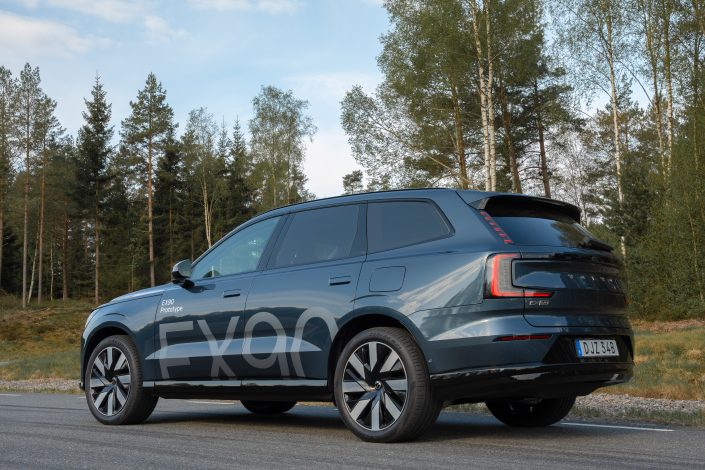
The Volvo EX90 is one of the few seven-seaters in the large electric SUV segment.
Keep challenging
Although no car is unsafe these days and its competitors are also bursting at the seams with passive and active safety systems, Volvo continues to challenge itself to take the next step again and again. This mainly lies in the nuance of how all systems work together to keep it not only as safe as possible for the occupants, but also as ‘bearable’ as possible. Nobody wants to drive a car where meddling systems drive you crazy and thus achieve the opposite of what they are intended for. An important role is reserved for ‘core computing’, which means that all the individual components and systems in the car no longer have their own operating systems and ECUs, but are instead centrally controlled by one computer. Program manager Mårten Wahlstedt gives the example of headlight supplier Hella. “They have their own software to control the headlights, but because we now develop that software in-house together with them, we can integrate it much better with the rest of our hardware and software.” A complex job, as it turned out; Volvo had to postpone the market introduction of the EX90 in July 2023 because they needed more time to get all the software surrounding the central computer in order. “We are concerned with achieving the most optimal ‘sensor fusion’,” continues Wahlstedt. “That comes down to finding the right mix and coordination to ensure that all safety systems work together optimally.” Not only for optimal safety, but also to minimize the aforementioned annoyance about overzealous warning systems.
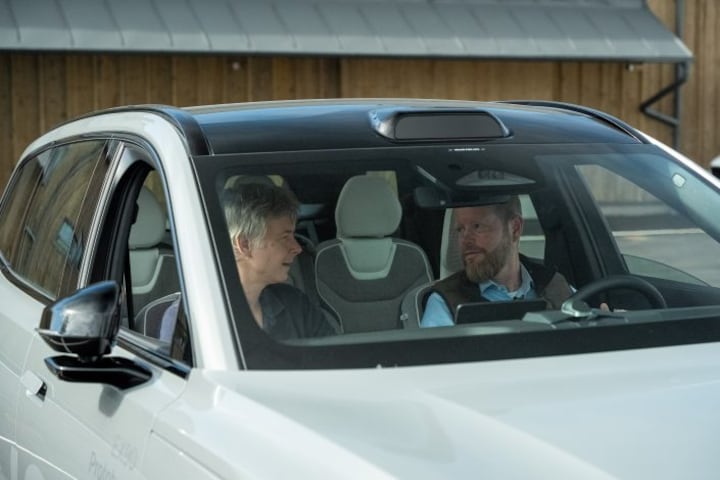
Program manager Mårten Wahlstedt (right) in conversation with AutoWeek’s Michiel Willebrands.
Safe and trusted
Volvo wants to make the EX90 not only the safest Volvo ever, but also the quietest and most comfortable. That’s where someone like Mattias Davidsson comes into play. The development driver has been responsible for tuning the chassis and steering at Volvo since 2006 and has been involved with the EX90 for the past four years. “That started with determining our goals with the car, then came the computer simulations and now we are in the very final phase of fine-tuning the car,” he starts as we drive under the barrier of the first section of the test track. . The EX90 must above all be comfortable, it is a message that Davidsson also repeats. “This car must feel safe and confident on all types of road surfaces, under all conditions.” The only form of ‘sportiness’ is the option to set the ‘suspension feel’ to ‘firm’ via the central screen. “The air suspension works with two chambers, you can compare it with two different sets of springs under your car. In the firmest position, one chamber is closed and the suspension becomes 25% stiffer,” he says as he taps the screen, after which the large SUV indeed feels significantly firmer. On the winding route, the semi-active dampers also help to prevent the carriage from tipping over. A task that could also be reserved for active stabilizer bars, if Volvo had not provided them for the EX90.

The driving behavior of the XC90 is mainly focused on comfort.
Only passenger
Although we are only passengers during the test round and a thorough assessment of the driving behavior of the EX90 will not be made until August, we can already conclude that the interior of the EX90 is particularly quiet and that the tuning of the chassis is solid and balanced. feels. With, indeed, the emphasis on comfort. Without the large, heavy SUV feeling ‘lumpy’. Large potholes and bumps are adequately absorbed by the dampers, the carriage is cushioned in a pleasant way. Volvo has now received around 700 orders for the EX90. If you would like to first view the car in detail and test drive it, it will be your turn at the end of September or beginning of October. Prices, versions and specifications are already known, which can all be found on our Carbase page of the Volvo EX90.
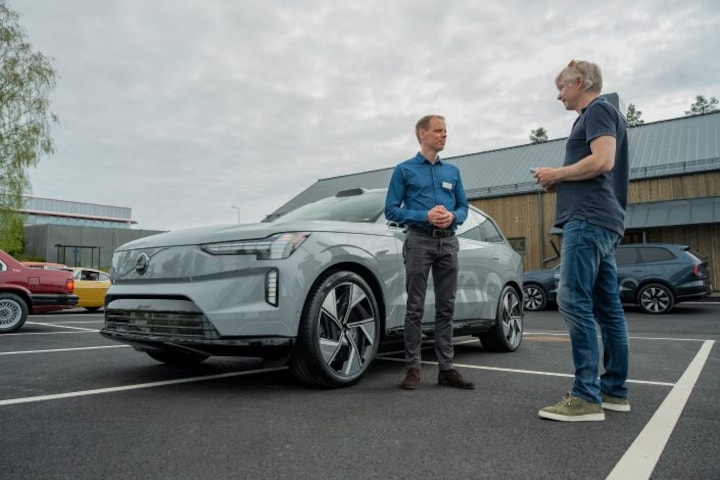
Test driver Mattias Davidsson: “This car should feel safe and confident on all types of road surfaces, under all conditions.”
– Thanks for information from Autoweek.nl